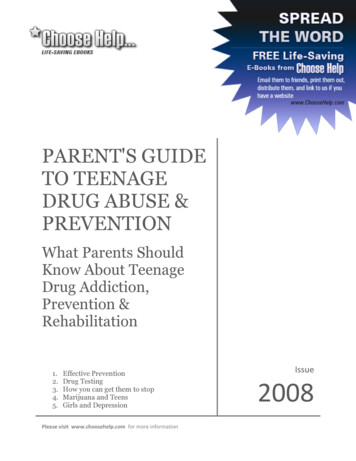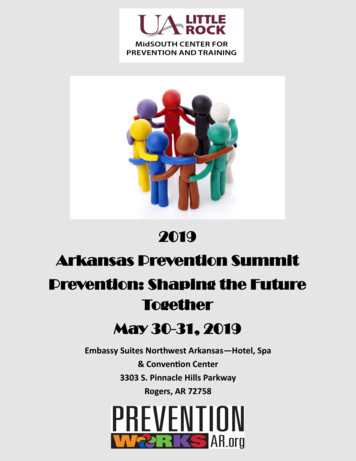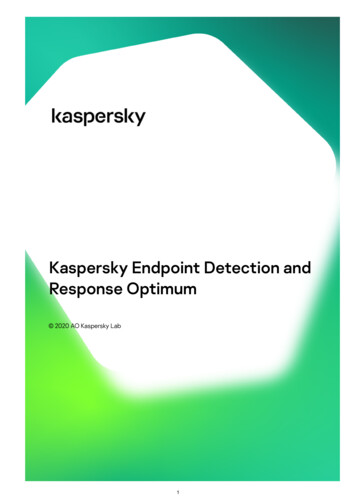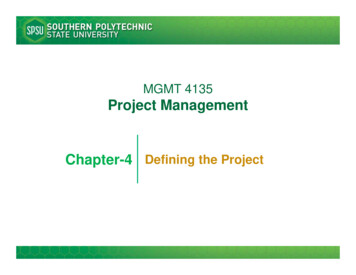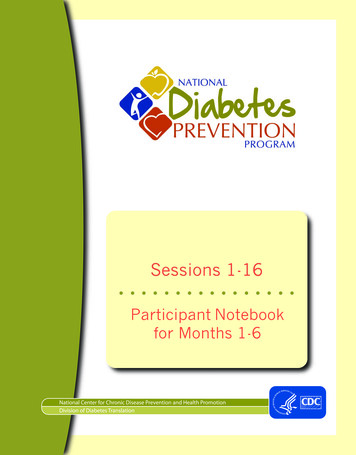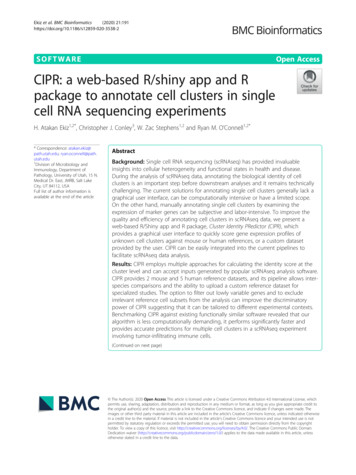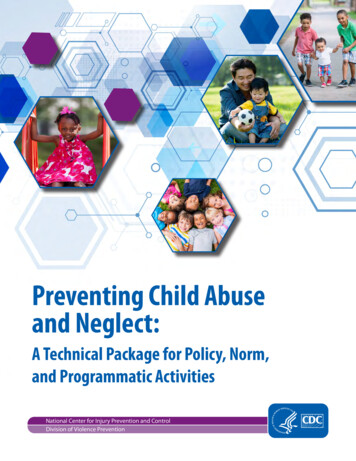
Transcription
Preventing Child Abuseand Neglect:A Technical Package for Policy, Norm,and Programmatic ActivitiesNational Center for Injury Prevention and ControlDivision of Violence Prevention
Preventing Child Abuse and Neglect:A Technical Package for Policy, Norm,and Programmatic ActivitiesDeveloped by:Beverly L. Fortson, PhDJoanne Klevens, MD, PhD, MPHMelissa T. Merrick, PhDLeah K. Gilbert, MD, MSPHSandra P. Alexander, MEd2016Division of Violence PreventionNational Center for Injury Prevention and ControlCenters for Disease Control and PreventionAtlanta, GeorgiaPreventing Child Abuse and Neglect: A Technical Package for Policy, Norm, and Programmatic Activities1
Centers for Disease Control and PreventionThomas R. Frieden, MD, MPH, DirectorNational Center for Injury Prevention and ControlDebra E. Houry, MD, MPH, DirectorDivision of Violence PreventionJames A. Mercy, PhD, DirectorSuggested citation:Fortson, B. L., Klevens, J., Merrick, M. T., Gilbert, L. K., & Alexander, S. P. (2016). Preventingchild abuse and neglect: A technical package for policy, norm, and programmatic activities.Atlanta, GA: National Center for Injury Prevention and Control, Centers for Disease Controland Prevention.2Preventing Child Abuse and Neglect: A Technical Package for Policy, Norm, and Programmatic Activities
ContentsAcknowledgements. 5External Reviewers. 5Strengthen Economic Supports for Families.13Change Social Norms to Support Parents and Positive Parenting.18Provide Quality Care and Education Early in Life .21Enhance Parenting Skills to Promote Healthy Child Development.25Intervene to Lessen Harms and Prevent Future Risk.29Sector Involvement.33Monitoring and Preventing Child Abuse and Neglect: A Technical Package for Policy, Norm, and Programmatic Activities3
AcknowledgementsWe would like to thank several individuals who contributed greatly to the development of this technical package. First,we give special thanks to Dr. Linda Dahlberg for her vision, guidance, and support throughout the development ofthis package. We thank Division, Center, and CDC leadership, and members of the CDC Division of Violence PreventionChild Maltreatment Workgroup for their careful review and helpful feedback on earlier iterations of this document.We thank Alida Knuth for her formatting and design expertise. We also extend our thanks and gratitude to all of theexternal reviewers for their helpful feedback, support and encouragement for this document.External ReviewersMarissa AbbottCalifornia Department of HealthJanet RosenzweigPrevent Child Abuse AmericaMelissa BrodowskiAdministration for Children and FamiliesElaine StedtAdministration for Children and FamiliesLauren FischmanAdministration for Children and FamiliesKiersten StewartFutures Without ViolenceMarilyn GisserWashington State Department of HealthCalondra TibbsNational Association of City and County Health OfficialsMonique Fountain HannaHealth Resources and Services AdministrationJulia WeiCalifornia Department of HealthCailin O’ConnorCenter for the Study of Social PolicySteve WirtzCalifornia Department of HealthDiane PilkeyHealth Resources and Services AdministrationMao YangAdministration for Children and FamiliesPreventing Child Abuse and Neglect: A Technical Package for Policy, Norm, and Programmatic Activities5
6Preventing Child Abuse and Neglect: A Technical Package for Policy, Norm, and Programmatic Activities
OverviewThis technical package represents a select group of strategies based on the best available evidence to help preventchild abuse and neglect. These strategies include strengthening economic supports to families; changing social normsto support parents and positive parenting; providing quality care and education early in life; enhancing parentingskills to promote healthy child development; and intervening to lessen harms and prevent future risk. The strategiesrepresented in this package include those with a focus on preventing child abuse and neglect from happening inthe first place as well as approaches to lessen the immediate and long-term harms of child abuse and neglect. Thesestrategies range from a focus on individuals, families, and relationships to broader community and societal change.This range of strategies is needed to better address the interplay between individual-family behavior and broaderneighborhood, community, and cultural contexts.1This package supports CDC’s Essentials for Childhood framework for preventing child abuse and neglect. In particular,it articulates a select set of strategies and specific approaches that can create the context for healthy children andfamilies and prevent child abuse and neglect (Goals 3 and 4 of the framework—see below).Commitment, cooperation, and leadership from numerous sectors, including public health, education, justice, healthcare, social services, business/labor, and government can bring about successful implementation of this package.What is a Technical Package?A technical package is a compilation of a core set of strategies to achieve and sustain substantial reductions in aspecific risk factor or outcome.2 Technical packages help communities and states prioritize prevention activities basedon the best available evidence. This technical package has three components. The first component is the strategy orthe preventive direction or actions to achieve the goal of preventing child abuse and neglect. The second componentis the approach. The approach includes the specific ways to advance the strategy. This can be accomplished throughprograms, policies, and practices. The evidence for each of the approaches in preventing child abuse and neglect or itsassociated risk factors is included as the third component. This package is intended as a resource to guide and informprevention decision-making in communities and states.Essentials for Childhood: Steps to Create Safe,Stable, Nurturing Relationships and EnvironmentsThe Essentials for Childhood framework proposes steps communities canconsider to promote the types of relationships and environments that helpchildren grow up to be healthy and productive citizens. The framework isorganized around four goals and related steps to promote safe, stable,nurturing relationships and environments for children and families.Four goal areas:1) raise awareness and commitment;2) use data to inform actions;3) create the context for healthy children and families through norms change and programs;4) create the context for healthy children and families through ials for childhood framework.pdfPreventing Child Abuse and Neglect: A Technical Package for Policy, Norm, and Programmatic Activities7
Preventing Child Abuse and Neglect is a PriorityChild maltreatment includes all types of abuse and neglect of a child under the age of 18 by a parent, caregiver, oranother person in a custodial role (e.g., clergy, coach, teacher) that results in harm, potential for harm, or threat ofharm to a child.3 There are four common types of child maltreatment:3 Physical abuse is the use of physical force, such as hitting, kicking, shaking, burning, or other shows of forceagainst a child. Sexual abuse involves inducing or coercing a child to engage in sexual acts. It includes behaviors such asfondling, penetration, and exposing a child to other sexual activities. Emotional abuse refers to behaviors that harm a child’s self-worth or emotional well-being. Examples includename calling, shaming, rejection, withholding love, and threatening. Neglect is the failure to meet a child’s basic physical and emotional needs. These needs include housing, food,clothing, education, and access to medical care.Child abuse and neglect is highly prevalent. Self-report data suggest that at least 1 in 7 children have experiencedchild abuse and/or neglect in the last year.4 Not all children, however, experience abuse and neglect at the same rates.Younger children are more likely to experience fatal abuse and neglect,5 while 14- to 17-year-olds are more likelyto experience non-fatal abuse and neglect.4 Race and ethnicity and family income are also factors that may affect achild’s exposure. Child protective services data show high rates of victimization among African-American children.African-American children experience abuse and neglect at rates that are nearly double those for white children. Thesedifferences are generally attributed to various community and societal factors, including poverty as well as differencesin reporting and investigation.5 Children living in families with a low socioeconomic status (SES)* have rates of childabuse and neglect that are five times higher than those of children living in families with a higher SES.6 Irrespective ofdata source, definitions, and measures, the true magnitude of child abuse and neglect is likely underestimated, andchildren of all ages, races, and ethnicities deserve safe, stable, nurturing relationships and environments to achievemaximal health and life potential.Child abuse and neglect is associated with several risk factors. Risk for child abuse and neglect perpetrationand victimization is influenced by a number of individual, family, and environmental factors, all of which interact toincrease or decrease risk over time and within specific contexts. Risk factors for victimization include child age andspecial needs that may increase caregiver burden (e.g., developmental and intellectual disabilities, mental healthissues, and chronic physical illnesses).7 Risk factors for perpetration include young parental age, single parenthood,large number of dependent children, low parental income, parental substance abuse, parental mental health issues,parental history of abuse or neglect, social isolation, family disorganization, parenting stress, intimate partnerviolence, poor parent-child relationships, community violence, and concentrated neighborhood disadvantage (e.g.,high poverty and residential instability, high unemployment rates).7 Although risk factors provide information aboutwho is most at risk for being a victim or a perpetrator of child abuse and neglect, they are not direct causes and cannotpredict who will be a victim or a perpetrator.Factors that protect or buffer children from being abused or neglected are known as protective factors. Supportivefamily environments and social networks consistently emerge as protective factors;7, 8 however, other factors suchas parental employment, adequate housing, and access to health care and social services may also serve to protectagainst child abuse and neglect. Unfortunately, no single factor tells the entire story about how and why child abuseand neglect occurs, and the risk and protective factors differ depending on the type of child abuse and neglect beingstudied. For additional information on risk and protective factors for child abuse and neglect, see Merrick, Fortson, andMercy9 and Fortson and Mercy.10* Defined as having a household income below 15,000 a year; parents’ highest education level less than high school; or any member of thehousehold a participant in a poverty program (e.g., TANF, food stamps, public housing, energy assistance, or subsidized school meals).68Preventing Child Abuse and Neglect: A Technical Package for Policy, Norm, and Programmatic Activities
The health and economic consequences of child abuse and neglect aresubstantial. Child abuse and neglect is associated with negative human,societal, and economic impacts. Children who are abused and neglectedmay suffer immediate physical injuries (e.g., cuts, bruises, burns, brokenbones), as well as emotional and psychological problems (e.g., posttraumaticstress, anxiety).11 Child abuse and neglect can also affect broader healthoutcomes, mental health, social development, and risk-taking behaviorinto adolescence and adulthood. Strong evidence confirms that childhoodviolence increases the risks of injury, sexually transmitted infections,including HIV, mental health problems, delayed cognitive development,reproductive health problems, involvement in sex trafficking, and noncommunicable diseases, which, in turn, can cause damage to the nervous,endocrine, circulatory, musculo-skeletal, reproductive, respiratory, andimmune systems.11,12 Given the high prevalence of child abuse and neglectand its vast consequences, the associated economic impact is substantial. Inthe United States, the total lifetime economic burden associated with childabuse and neglect was approximately 124 billion in 2008.13Child abuse and neglect is preventable. Much progress has been madein understanding how to prevent child abuse and neglect. Child abuse andneglect is the result of the interaction of a number of individual, fam ily, andenvironmental factors.14 Consequently, there is strong reason to believe thatthe prevention of child abuse and neglect requires a comprehensive focus thatcrosscuts key sectors of society (e.g., public health, government, education,social services, and justice).15 In addition, there is an important need toincrease the capacity of state and local governments to implement and scaleup effective interventions that can reduce child abuse and neglect.16,17Preventing child abuse and neglect can also prevent other forms of violence. Each of the various forms ofviolence are interrelated and share many risk and protective factors,18 consequences,19,20 and effective approachesto prevention.21 Given the overlap of the risk and protective factors for child abuse and neglect and other formsof violence, it stands to reason that the primary prevention of child abuse and neglect can prevent other forms ofviolence and abuse.18,22 Moreover, strategies that support the development of safe, stable, and nurturing relationshipsbetween parents or caregivers and their children could be key in preventing the early development of violentbehavior in children.23-25 Emerging evidence suggests that by stemming the early development of violent behavior,such relationships can also reduce many types of violence occurring in adolescence and early adulthood, such asyouth violence, intimate partner and dating violence, sexual violence, and self-directed violence.26Assessing the EvidenceThis technical package includes programs, practices, and policies with evidence of impact on child abuse and neglectvictimization, perpetration, or risk factors for child abuse and neglect. To be considered for inclusion in the technicalpackage, the program or policy selected had to meet at least one of these criteria: a) meta-analyses or systematicreviews showing impact on child abuse and neglect victimization or perpetration; b) evidence from at least one ormore rigorous (e.g., randomized controlled trial [RCT] or quasi-experimental design) evaluation study that foundsignificant preventive effects on child abuse and neglect victimization or perpetration; c) meta-analyses or systematicreviews showing impact on risk factors for child abuse and neglect victimization or perpetration; or d) evidence fromat least one rigorous (e.g., RCT or quasi-experimental design) evaluation study that found significant impacts on riskfactors for child abuse and neglect victimization or perpetration. Finally, consideration was given to the likelihoodof achieving beneficial effects on multiple forms of violence; no evidence of harmful effects on specific outcomes orwith particular subgroups; and feasibility of implementation in a U.S. context if the program, policy, or practice wasevaluated in another country.Preventing Child Abuse and Neglect: A Technical Package for Policy, Norm, and Programmatic Activities9
Within this technical package, some approaches do not yet have research evidence demonstrating impact on ratesof child abuse and neglect victimization or perpetration but instead are supported by evidence indicating impactson risk factors for child abuse and neglect (e.g., parenting stress, parental mental health). In terms of the strength ofthe evidence, programs that have demonstrated effects on child abuse and neglect outcomes provide a higher levelof evidence, but the evidence base is not that strong in all areas. For instance, there has been less evaluation of theeffects of community and societal level approaches in preventing child abuse and neglect. Thus, approaches in thispackage that have effects on risk factors reflect the developmental nature of the evidence base and the use of the bestavailable evidence at a given time.It is also important to note that there is often significant heterogeneity among the programs, policies, or practicesthat fall within one approach in terms of the nature and quality of the available evidence. Not all programs, policies, orpractices that utilize the same approach (e.g., home visitation) are equally effective, and even those that are effectivemay not work across all populations. Very few evaluation studies have assessed outcomes across diverse populations(e.g., racial/ethnic; populations with disabilities). Moreover, not all programs were designed for use with diversepopulations; thus, tailoring of programs and more evaluation may be necessary to address different populationgroups. The examples provided, while not intended to be a comprehensive list of evidence-based programs, policies,or practices, illustrate models that have been shown to impact rates of child abuse or neglect or have empiricalsupport demonstrating impact on risk factors for child abuse or neglect. In practice, the effectiveness of the programs,policies and practices identified in this package will be strongly dependent on the quality of their implementation.Implementation guidance to assist practitioners, organizations and communities will be developed separately.Contextual and Cross-Cutting ThemesThe strategies and approaches that have been included in this technical package represent different levels of the socialecology, with efforts intended to impact the community and societal levels, as well as individual and relationship levels.The strategies and approaches are intended to work in combination and reinforce each other to prevent child abuse andneglect (see box below). The strategies are arranged in order such that those strategies hypothesized to have the greatestpotential for broad public health impact on child abuse and neglect are included first, followed by those that mightimpact more select populations (e.g., first-time parents or those for whom child abuse and neglect is already present).Preventing Child Abuse and NeglectStrategyApproachStrengthen economicsupports to families Strengthening household financial security Family-friendly work policiesChange social norms to supportparents and positive parenting Public engagement and education campaigns Legislative approaches to reduce corporal punishmentProvide quality care andeducation early in life Preschool enrichment with family engagement Improved quality of child care through licensing and accreditationEnhance parenting skills to promotehealthy child development Early childhood home visitation Parenting skill and family relationship approachesIntervene to lessen harms andprevent future risk 10Enhanced primary careBehavioral parent training programsTreatment to lessen harms of abuse and neglect exposureTreatment to prevent problem behavior and later involvement inviolencePreventing Child Abuse and Neglect: A Technical Package for Policy, Norm, and Programmatic Activities
The strategies andapproaches that havebeen included in thistechnical package representdifferent levels of the socialecology, with efforts intendedto impact the communityand societal levels, as wellas individual andrelationship levels.The prevention of child abuse and neglect has the potential to impact other forms of violence across the life course.Although each of the strategies and approaches was selected based on its potential impact on child abuse andneglect, impacts on other forms of violence may be observed, thereby reflecting the interconnectedness and overlapbetween the risk and protective factors for child abuse and neglect and the risk and protective factors for other formsof violence.18,21 For example, programs that address the behavior problems of young children have demonstratedeffectiveness in preventing the recurrence of child abuse and neglect perpetration,27,28 as well as in reducingdelinquency and crime in later adolescence and adulthood.29 Home visiting programs and early care and educationprograms have been shown to reduce adolescent arrests and delinquency30 and prevent adult involvement in criminalbehavior.31-33 Thus, implementation of strategies and approaches aimed at preventing child abuse and neglect havesubstantial potential to prevent other types of violence.Each community and organization working on the prevention of child abuse and neglect across the nation bringsits own social and cultural context to bear on the selection of strategies and approaches that are most relevant toits populations and settings. Practitioners in the field may be in the best position to assess the needs and strengthsof their communities and work with community members to make decisions about the combination of approachesincluded here that are best suited to their context.This package includes strategies where public health agencies are well positioned to bring leadership and resourcesto implementation efforts. It also includes strategies where public health can serve as an important collaborator (e.g.,strategies addressing community and societal level risks), but where leadership and commitment from other sectorssuch as business/labor is critical to implement a particular policy or program (e.g., family-friendly work policies).The role of various sectors in the implementation of a strategy or approach in preventing child abuse and neglect isdescribed further in the section on Sector Involvement.In the sections that follow, the strategies and approaches with the best available evidence for preventing child abuseand neglect are described.Preventing Child Abuse and Neglect: A Technical Package for Policy, Norm, and Programmatic Activities11
12Preventing Child Abuse and Neglect: A Technical Package for Policy, Norm, and Programmatic Activities
Strengthen Economic Supports for FamiliesRationalePolicies that improve the socioeconomic conditions of families tend to have the largest impacts on health.34 Strongempirical evidence consistently links low income to children’s development, academic achievement, and health,35,36including exposure to child abuse and neglect.37 Policies that strengthen household financial security can reducechild abuse and neglect by improving parents’ ability to satisfy children’s basic needs (e.g., food, shelter, medical care),provide developmentally appropriate child care, and improve parental mental health.Policies can change the context for families by improving the balance between work and family (“family-friendlywork”), thereby allowing parents to provide the necessary care for children and increasing the likelihood that childrenexperience safe, stable, nurturing relationships and environments. Studies show several “family-friendly” work policiesreduce risk factors for child abuse and neglect, such as stress and depression.ApproachesEconomic supports for families can be strengthened by targeting household financial security and family-friendly work.Strengthening household financial security can reduce child abuse and neglect by improving parents’ ability tosatisfy children’s basic needs (e.g., food, shelter, medical care), provide developmentally appropriate child care, andreduce parental stress and depression, both risk factors for child abuse and neglect.37 Strengthening householdfinancial security may also reduce children’s exposure to crowding and contribute to residential stability and stabilityin child care arrangements. Household financial security can be strengthened in various ways: Child support payments: States can modify how Temporary Assistance for Needy Families (TANF) benefitsare affected by child support payments. In many states, the child support payments are used by the state toreimburse itself, but states may also elect to allow some or all of the child support payment to be passed on tothe custodial parent and child without any reduction in the TANF benefits. Allowing child support paymentsto be passed on to the custodial parent in part or in full without reducing TANF benefits increases householdincome. Tax credits for families with children (e.g., state and federal Earned Income Tax Credit, EITC) help low incomefamilies increase their income while incentivizing work or offsetting the costs of child-rearing. The federal EITCis a refundable credit originally designed to encourage work by offsetting the impact of federal taxes on lowincome families. The amount of the credit varies depending on income earned through work, marital status,and the number of qualifying children. State EITC’s are usually based on a percentage of the federal EITC andvary in their eligibility and funding amounts; approximately half of the states in the U.S. have enacted EITCs.38 State options for managing federal nutrition assistance programs: The Supplemental Nutrition AssistanceProgram (SNAP) is a federally funded program managed by the U.S. Department of Agriculture (USDA)that provides cash benefits, which can only be used to purchase food, to low income households. Stateshave several options that can facilitate access to SNAP (e.g., online application; frequency or simplicity withwhich households report household income or work hours; whether child support is considered in incomecalculations; disqualifications imposed).39 SNAP benefits help low income parents meet children’s basic needsfor food. Because SNAP benefits allow a parent’s income from other sources to be used on things besides food,SNAP decreases family poverty and poverty among children.40 SNAP also reduces the severity of food insecurity.41Preventing Child Abuse and Neglect: A Technical Package for Policy, Norm, and Programmatic Activities13
Assisted housing mobility: States can choose to use the U.S. Housing and Urban Development’s CommunityDevelopment Block Grant (CDBG) money to purchase properties in low poverty neighborhoods and leasethem to low income families at lower rent.42 Alternatively, states can use Section 8 Housing Choice Voucherfunds and condition their use to rentals in low poverty neighborhoods, while at the same time coupling themwith measures that prevent discriminating against Section 8 voucher holders.42 Assisted housing mobilitythrough these programs enables families from high poverty neighborhoods to relocate to more stable, betterresourced, and safer communities while saving on rent. These savings can be used for other necessities. Subsidized child care provides vouchers, lower cost child care, or cash transfers to low-income families tooff-set the cost of quality, full-time child care. Subsidized child care improves low income families’ economicwell-being by reducing child-care costs; many parents receiving subsidies report that the subsidies enhancetheir financial well-being.43 States can elect to raise income threshold limits to expand eligibility and considerhousehold expenses when calculating eligibility; expand the definition of approved activities to includetraining, education, job search time, rest hours (for parents working second or third shifts), and temporaryleave; increase the amount of the subsidy, provide increases based on the quality of care provided, andimprove monitoring of quality; have graduated phase-out periods that would allow clients to slowly earn theirway off the program rather than face a blunt income threshold; simplify the application process and shortenwait times for subsidy approval; simplify the verification process, the reapplication process, and reduce thefrequency of recertification to improve continuity of child care; and increase the number of providers withnon-standard hours (e.g., evenings, weekends) or incentivize providers to provide extended hours.Family-friendly work policies change the context for families by improving the balance between work and familywhile ensuring economic security. This makes it easier for parents to provide necessary care for children. Livable wages allow working parents enough income to cover the costs of living and provide for theirchildren’s basic needs (e.g., food, shelter, appropriate child and medical care), reducing the likelihoo
What is a Technical Package? A technical package is a compilation of a core set of strategies to achieve and sustain substantial reductions in a specific risk factor or outcome.2 Technical packages help communities and states prioritize prevention activities based on the best available evidence. This


